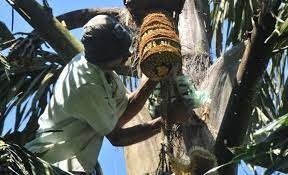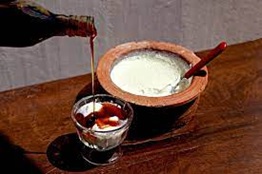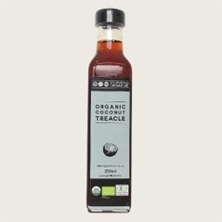PALM TREACLE
Coconut, Kithul, and Palmyrah treacle

Harvesting the sap from the Kithul palm flower
What is it…?
- Treacle is a thick dark syrup or viscous uncrystallised liquid produced by heating the sweet sap of the palm tree. Palm sap is a water solution of sugar
- Sap (noun) – the fluid which circulates in the vascular system of a plant, consisting chiefly of water with dissolved sugars and mineral salts. It is collected by a process called ‘tapping’ which involves snipping off the stem of the palm flower and letting the sweet translucent liquid (sap) drip into a container
- The preparation of treacle is a process of concentrating the sugar by heat treatment through evaporation of water
- Treacle can be produced by many different plants such as the Palmyrah palm (Borassus Flabellifer), coconut palm (Cocos Nucifera), kithul palm (Caryota Urens) and sugar cane.
- In Sri Lanka, palm treacle is produced by three types of plants including Kithul, Coconut and Palmyrah palms
… Palm treacle has been a sweetener in various traditional sweets and deserts in Sri Lanka since ancient times – following is a brief introduction of palm treacle as a functional food (rich in antioxidants, vitamins and minerals), produced by mainly three palm varieties endemic to Sri Lanka
How is it used…?
- Treacle can be taken on its own in a spoonful and has a variety of other food uses including in sweets, biscuits and cakes, breakfast cereals, granola, and as toppings for puddings, ice cream, yoghurt, curd, and fruits
- The sweet translucent liquid sap extracted from the palm flower is used to produce many natural products including jaggery, vinegar, sugar, syrup, treacle and toddy … a mildly alcoholic drink commonly consumed in villages

Making treacle from palm sap
How does it benefit our health?
- Coconut treacle is sugar rich and consists of 65-75% sugars and water content about 25-30%, with other constituents like proteins, organic acids, minerals, vitamins, phenolic compounds and amino acids
 Buffalo curd with sweet Kithul treacle
Buffalo curd with sweet Kithul treacle
- Coconut sap is known to be rich in antioxidants and is known to inhibit alpha-amylase activity thus becoming a low-glycaemic index food used as a therapeutic agent in treating type II diabetes mellitus
- Compared with regular sugar (GI of 65), coconut treacle has a lower Glycaemic Index (GI) of around 35, and a rich source of antioxidants and phytonutrients
- Coconut treacle is a naturally sweet syrupy liquid high in vitamins and minerals including vitamin C, vitamins B1, B2, B3, B6, magnesium, calcium, potassium, zinc and iron
- Kithul treacle is high in protein, whereas Palmyrah treacle is high in sodium and Potassium
- Coconut treacle is highest of the three in Total Phenolic Compounds, TPC activity. Phenolic compounds act as antioxidants by reacting with a variety of free radicals.
- TPC was significantly high for coconut treacle while there are no significant differences between Kithul and Palmyrah treacle
Specifications
Physiochemical properties of different palm treacle
Parameter – g/100g | Palmyrah | Coconut | Kithul |
Total ash | 0.0775 | 0.0592 | 0.0142 |
Moisture | 26.84 | 24.24 | 24.56 |
Acidity | 0.294 | 0.144 | 0.204 |
Acid insoluble ash – Mineral | 0.0016 | 0.0080 | 0.0021 |
Total sugars | 67.902 | 66.81 | 65.51 |
pH | 5.97 | 3.86 | 4.52 |
Total soluble solids – Brix | 69.34 | 73.96 | 74.26 |
Sri Lanka Standards (SLS 778) – Treacle specification
Parameter | % by mass – SLS 772 |
Moisture | 30 (maximum) |
Total sugar | 65 (minimum) |
Acidity | 0.5 (maximum) |
Total ash | 1.5 (maximum) |
Acid insoluble ash | 0.15 (maximum) |
Protein, Na, K level of different palm treacle
Parameter – mg/100g | Palmyrah | Coconut | Kithul |
Protein | 0.2883 | 0.4103 | 0.5703 |
Na | 33.5 | Not detected | Not detected |
K | 87.16 | Not detected | Not detected |
Source: Aheeshan. B et al. ‘Antioxidant activity and physiochemical analysis of Coconut, Kithul and Palmyrah palm treacle’, JSc EUSL (2022), Vol. 13, no. 1, p 23-30)
Offerings
Labelled bottles – Retail LCL lots only
Packing Options
Packaging tier | Type |
Primary | Glass Bottle – 360ml net |
Secondary | Cardboard carton – holds 1 Doz. bottles |
Tertiary | Pallet |
Note:
As Kithul and Palmyrah sap are scarce and seasonal in nature, order quantities may be limited
Contact Us For More Details
Nivanbima (Pvt) Ltd
No. 117/2/40, Prime Urban Art, Horahena Road, Kottawa
Sri Lanka
Post code. 11129
Mobile : +94 76 388 8202


